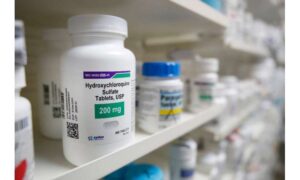
Hydroxychloroquine is an anti-malarial drug that helps prevent malaria infection and provides relief from the symptoms of malaria when you get it. It’s used to treat multiple sclerosis (MS), rheumatoid arthritis, systemic lupus erythematosus, sarcoidosis, granulomatous disease, and other inflammatory diseases. This medication comes in oral tablets and oral solution forms. It may also be used for purposes not listed in this medication guide. Hydroxychloroquine may also be used for purposes not listed in this medication guide.
What Is It?
Hydroxychloroquine is a medication used to prevent and treat malaria. It is also used to treat lupus erythematosus and rheumatoid arthritis. The drug is similar to chloroquine and carries many of the same side effects. However, it does not have the potential for neurological toxicity seen with chloroquine. One of the most common side effects of hydroxychloroquine is gastrointestinal upset such as nausea, vomiting, diarrhea, or abdominal pain. Other less common but serious side effects include low blood cell counts (thrombocytopenia), elevated liver enzymes (liver injury), and lung problems (pulmonary fibrosis). These are all reasons that you should see your doctor before taking this medication!
How To Take It
Hydroxychloroquine is usually taken with food or milk to prevent stomach upset. The dosage and length of treatment are based on your medical condition and response to therapy. In children, the dosage may also be based on weight.
What Are The Side Effects?
The most common side effects are nausea and diarrhea. These effects are usually mild and go away on their own. Other common side effects include headache, dizziness, skin rash, and itching. Rare side effects include changes in heart rhythm, mental confusion, and vision problems. If you experience any of these side effects, stop taking hydroxychloroquine and call your doctor right away.
Who Should Not Take It?
People with psoriasis should not take hydroxychloroquine. The drug can increase the risk of a rare but serious condition called exfoliative dermatitis. People with heart disease, diabetes, or a history of alcohol abuse should also avoid the drug. Pregnant women and people who are breastfeeding should not take hydroxychloroquine.
When Should I Stop Taking It?
Hydroxychloroquine 200 mg is usually taken for 3-5 days. The length of your treatment will depend on your condition and how well you respond to the medication. If you’re feeling better and your infection appears to be cleared up, your doctor may tell you to stop taking hydroxychloroquine.
Alternatives To Hydroxychloroquine
If you’re looking for an alternative to hydroxychloroquine, there are a few options available. These include chloroquine, quinacrine, and mefloquine. Each of these has its own benefits and drawbacks, so be sure to speak with your doctor before making a decision. – Chloroquine is a good choice if you need high doses or if your disease has progressed to the stage where the treatment needs to start earlier in the course of the disease.
– Quinacrine is often used as maintenance therapy following one year of hydroxychloroquine therapy, or for cases where there’s no history of joint damage and diagnosis is made based on symptoms only.
– Mefloquine can cause neurological side effects such as mood changes and seizures in some people who take it. It’s also not recommended for use during pregnancy or breastfeeding because it can affect blood cells.
